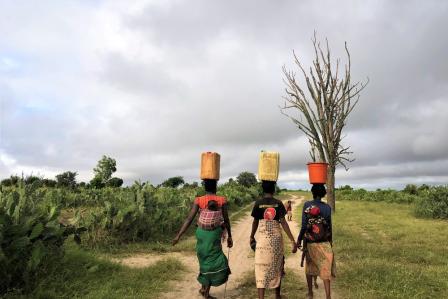Madagascar: Communities face dual storms amid worsening climate crisis
_a6c1.jpg?itok=dIxzMdJ5)
The land still flooded after the passage of Cyclone Honde. Madagascar, March 2025. © Nomena Tiavina Rajerison/MSF
“Our lives have been completely turned upside down by cyclone Honde. Just a month earlier [February], we had already been struck by a storm. I must admit, the future looks very difficult,” confides Jean Biscotin, a resident of Behompy, one of the hardest-hit rural communes in the Atsimo Andrefana region of Madagascar. “What scares me the most now is the possibility of more cyclones hitting us again.”
Two weeks later, storm Jude swept through the southern part of the country.
Cyclone Honde hit the southern regions of Androy, Anosy, Ihorombe, Menabe, and Atsimo Andrefana, with winds reaching 120 km/h and gusts up to 165 km/h. Two weeks later, storm Jude swept across three of these regions and left nearly 200,000 people affected, displaced over 46,000, and caused 13 deaths. The flooding and violent winds damaged critical infrastructure and submerged thousands of hectares of crops.
“I cannot even describe how difficult it is and how much we are suffering. Today, we have nothing left: no food, no shelter,” says Nordine, a farmer in Behompy in the Tuléar II district. “The cyclones have devastated our land. The crops we should have been eating now have all been destroyed or washed away. Our homes have been ravaged.”
At the beginning of March, teams from Doctors Without Borders/Médecins Sans Frontières (MSF) travelled to the island’s southwest—one of the hardest-hit areas—to respond to urgent needs and assess the full extent of the health impact. On 5 March our teams launched activities in the Tuléar II district, initially in response to Honde, before expanding their efforts following the passage of Jude.
Tuléar II, located in the Atsimo Andrefana region, is a highly isolated area that suffered severe damage from both Honde and Jude. Access became even more challenging due to rising waters and blocked roads, significantly delaying aid deliveries, particularly to coastal towns. It took Doctors Without Borders emergency teams nearly three days to transport relief supplies from the capital, Antananarivo, to the district.
As they moved toward the disaster-stricken areas, our teams witnessed the devastation firsthand.
“The state of the roads worsened as we advanced,” says Narcisse Wega, Doctors Without Borders Mission Chief in Madagascar. “Four days after cyclone Honde struck, many roads remained flooded or obstructed, making it difficult to deliver aid and reach the worst-affected areas.”
“After Jude, our teams had to wait several days before setting out to sea for interventions along the southwest coast because road was cut off,” Wega continues. “With strong winds, crossing was impossible, while some of the hardest-hit communes were located 30 km from Tuléar, requiring around 30 minutes by boat.”
_7af4.jpg?itok=K7J6IBR5)
Alongside the communities in the southwest of Madagascar, Doctors Without Borders teams have conducted medical consultations after Cyclone Honde. A mobile clinic was set up in the rural communes of Belalanda and Behompy to support and provide care to the victims. Madagascar, March 2025. © Nomena Tiavina Rajerison/MSF
“The cyclones damaged the solar system that kept the district’s cold chain running, disrupting routine childhood vaccinations and leaving children at risk “, says Wega. “In Ankilimivony, one of the hardest-hit communes in Tuléar II, we found a health centre completely unroofed by the violent winds. “Without a roof, it was unusable”, he says. “Local health workers had to use their own homes to continue treating patients.”
In four weeks of activities, eight mobile clinic sites were set up across seven of the hardest-hit communes—Behompy, Belalanda, Miary, Betsinjaka, Anakao, Beheloka, and Soalara Sud. Through them, teams provided medical care to 2,817 people in coordination with local authorities. Additionally, food and hygiene kit distributions supported 1,289 households. Each family received food, soap, and water purification solution. Doctors Without Borders donated supplies to the Tuléar II health district to ensure treatment for severe acute malnutrition cases identified during our mobile clinics and provided equipment for the rehabilitation of the Ankilimivony health centre after Jude.
Madagascar is one of the countries most vulnerable to climate change. Each year, from November to April, the country faces a cyclone season that further weakens already fragile communities. Situated in the Indian Ocean, the island is regularly affected by extreme weather events, which have intensified due to climate change. Since 2022, 12 tropical storms and cyclones have struck the island during cyclone seasons, affecting more than two million people and causing significant material damage.
In the south of Madagascar, a region already suffering from recurring droughts and limited access to basic infrastructure, cyclones further disrupt an already fragile balance. Most inhabitants of these rural areas are farmers, whose livelihoods depend heavily on climatic conditions, making them particularly vulnerable to environmental shocks. This vulnerability has also been observed in the Ikongo district of the Fitovinany region, where Doctors Without Borders has been operating since 2022.
“We are particularly worried about the increasing frequency of these climate shocks,” says Wega. “At this rate, it is becoming increasingly difficult for communities to recover after each catastrophe.”
Since the beginning of the year, following an abnormally dry rainy season, Madagascar has already faced three cyclones and multiple episodes of heavy rainfall. This includes the rain which led to the floods in Antananarivo on 16 February and 22 March, where our teams distributed hygiene and food kits to affected communities.
Doctors Without Borders in Madagascar
In Madagascar, Doctors Without Borders works closely with local authorities to respond to epidemiological emergencies and natural disasters. In 2022, Doctors Without Borders teams intervened after cyclones Batsirai and Emnati, initially to support affected communities and later to treat people for malnutrition. Today, we continue our work in the Ikongo district, providing basic healthcare and paediatric services.
Will you support our emergency response work?
Help us provide lifesaving medical care during emergencies by making a donation today.
